Timber cladding in Scotland
The study outlines the development of timber cladding in Scotland, describes timber clad buildings in Scotland, and provides practical information on the use of timber cladding in Scotland.
Timber Cladding in Scotland
SCOTS PINE (Pinus sylvestris)
The use of European oak for external cladding in Scottish towns gave way to Scots pine in the late mediaeval period. Exactly when this occurred is uncertain, but new trade developed with south-west Norway around 1500 and this is likely to have been an important factor.
The 'Scottish Trade' (Skottahandelen) with Norway was a direct trade between the skippers of Scottish ships and the local farmers in the Ryfylke region of Norway. It was a barter system: the Scots traded cereals for timber (mainly redwood but with occasional pieces of oak), whilst avoiding the customs duties of Stavangar, the trading port. The Scottish Period 'Skottatida' lasted from c.1500 to 1717 when Stavanger managed to impose a ban on the Scots and other foreigners sailing up the fjords to trade. Other districts included in the Skottahandelen were M¯reord Tr¯ndelag to the north and other areas outside the main forestry region which ran eastwards from Agder (7). Half the Scottish ships came from Fife and a quarter from Tayside, Dundee providing the largest number from a single port. Homegrown Scots pine was also utilised when available, although supplies were intermittent.
Scots pine was recorded under a number of trade names which were mainly derived from either the region of growth (e.g. Baltic fir, Scots pine), the port of export (e.g. Riga pine, Memmel pine), the colour of the timber (e.g. redwood, yellow deal) or some combination of these (e.g. Kara Sea redwood). Nowadays BS 7359 requires that the import of P. sylvestris timber from the continent of Europe be called 'redwood', while UK-grown timber be specified as 'Scots pine'. Unlike oak, Scots pine was mainly sawn on account of the larger number of knots which made cleaving long lengths difficult, although this method was employed in the manufacture of Scots pine roof shingles.
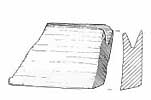 |
CHANGES IN THE TRADE The use of oak and Scots pine reduced in importance throughout Europe in the late mediaeval period due to a general shortage of timber and a move towards stone or brick construction. The latter change was probably due to increasing affluence, improved overland transportation, and the introduction of a more Italianate-style of building popularised by the works of Palladio. Tropical timber imports began to appear in the 18th century, albeit on a very restricted scale at first. |
Example of a fragment of oak cladding from Edinburgh |
CULTURAL AND ECONOMIC INFLUENCES
POVERTY
Early travellers' accounts give an impression of mediaeval Scotland. One of the best collections of pre-1700 travel notes was assembled and published by Hume Brown (8), in the preface of which he stresses that comparing Scotland directly with rich countries such as England or France is misleading and that it should be compared instead with lesser north European nations such as Norway or Sweden.
Much of the housing would have been of a temporary nature. Jean Froissart, accompanying a French army to Scotland in 1385 and reporting on the Scottish attitude to English invasions, states:
If the English do burn our houses what consequence is it to us? We can rebuild them cheap enough, for we only require three days to do so, provided we have five or six poles and boughs to cover them.(8)
DUTCH INFLUENCES
Prior to the Union of the Crowns in 1603, at least 90% of Scottish exports were to the Low Countries. The Scottish base was at Veere and Scottish buildings from this period were remarkably similar to those in Belgium and the Netherlands. Timber buildings appear to develop in tandem between Scotland and the Low Countries until, in the century following the Union of the Crowns, trade with the Low Countries virtually ceased. Thereafter Scotland (or North Britain as it then became known) grew increasingly under the cultural and technological influence of England. Instead of continuing to build in timber, the Low Countries gradually moved towards brick and tile, whilst Scotland moved towards stone and slate.
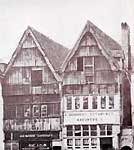
|

|
Prior to 1603, Scottish buildings were remarkably similar to those in Belgium and the Netherlands, as in these two examples from Malinas, Belgium and Mahogany Land, West Bow, Edinburgh. |
|
LEGISLATION
The towns of mediaeval Scotland were overcrowded, resulting in a progressive introduction of local and national legislation to control the risk of fire. The impact of this legislation was the most significant factor in the eventual disappearance of timber cladding in urban Scotland.
Mediaeval Scottish towns were organised through an administrative system of royal burghs which were set up by the Crown with a range of rights and privileges to provide them with income. The first royal burghs were established by King David 1 in the 12th century, with each administration controlled by a Dean of Guild who was responsible for introducing legislation including the banning of various flammable materials from dwellings and building construction.
Early legislation appeared in response to specific incidents or disasters in a particular burgh. Occasionally legislation stemmed from decisions reached by the Convention of Royal Burghs but not every burgh within the convention adopted every recommendation. Generally building legislation in Scotland followed north European models. This happened in a number of stages:
1 A complete timber structure with an 'eaves drop' i.e. a space between adjoining buildings on to which water dripped from the eaves. (The space was not wide enough to be used as a passageway but did provide a convenient place to secretly listen in on conversations within a building. Hence the phrase 'to eavesdrop');
2 A non-combustible 'fire-safe' was added to the rear of the property to protect valuables from fire (eavesdrops and firesafes can still be seen in the Bryggens area of Bergen, Norway). Early fire-safes tended to be square on plan and multi-storey (as can be seen in the towers of San Gimignano, Italy). Gradually the fire safes adopted squatter forms and by the 17th century had become long, low, rectangular structures. A number of fire-safes still survive in Scotland, albeit in altered form - Abertaff House in Inverness being the best known example;
3 Eaves drops were subsequently infilled with a non-combustible party wall of masonry or brick;
4 Non-combustible rear walls were next;
5 A requirement for a complete non-combustible core to the dwelling followed, although timber galleries on the principal facade were still allowed;
6 Lime pargetting or rendering over thetimber facade gave the appearance of harled masonry. Building legislation in Edinburgh banned the construction or rebuilding of timber structures, and neighbours registered complaints every time replacement boards or timbers were introduced as part of routine maintenance of existing timber buildings on the grounds that this constituted rebuilding. Lime rendering may thus have been a reaction to those claims of rebuilding lodged by neighbours when maintenance was necessary.
7 Finally, by the 17th century, completely non-combustible facades and party walls were required.
THE HISTORY OF EARLY TIMBER CLADDING
The gradual evolution of timber cladding is reflected in different types of buildings:
RELIGIOUS BUILDINGS
Some of the earliest evidence for timber cladding in Scotland comes from accounts of religious buildings. Saltzman (9) quotes the Venerable Bede (c.673-735) in part of his statement:
Until the 11th century it was exceptional for even a church to be built in stone. Finan, in about 655, built a church at Lindisfarne, not of stone, but, in the Scottish fashion of cleft oak.
This could refer to the type of cruck-framed, hog-backed structure depicted in the hog-backed tombstones of that period, while the 'Scottish fashion' suggests the techniques used by the Scots who moved out of Ireland into Southern Scotland (the name of the monastic settlement of Iona may be derived from the Irish name for a yew tree on account of the buildings being clad with Irish yew shingles). It is not until the 12th century that timber gave way to masonry in the most important ecclesiastical buildings, but many smaller churches and monastic settlements were still built and clad in timber long after this.
DEFENSIVE BUILDINGS
A similar situation existed with castles and other defensive structures. Macgibbon and Ross (10) described the gradual change from timber to stone castles:
It is curious to trace the history of the use of wood in the construction of defences of mediaeval castles. At first we find the whole of the erections in the castle, with its dependencies and enclosing palisade, constructed entirely from wood. The first change was the introduction of stone for the construction of the keep, or chief stronghold, which was thus rendered secure against fire. Then it was found desirable to prevent the enclosing fortifications from being easily destroyed by fire and a stone wall substituted for the wooden palisade. Wooden defences are still adhered to but they are now raised to the top of the walls in the form of hoards ... by and by the engines of attack became powerful enough to throw missiles which destroyed these hoards, and fire-balls which set them on fire. It then became necessary to make the hoards of stone; but this change is introduced very gradually. First stone corbels are used instead of wooden putlogs to support the wooden stays, then larger corbels are substituted for the wooden struts ... and finally the hoarding or parapet itself is built with stone. This last change did not take place till about the beginning of the 14th century.
Stokesey Castle on the Welsh borders gives some idea of what 14th century Scottish fortified houses might have looked like. These were the castles of the upper echelons of the nobility, however, and it took a long time for masonry construction to become the norm even amongst the lesser nobility and rich merchants. It might be argued that there is no evidence for large timber structures surviving at any of the major castle sites in Scotland, but of those plans of surviving structures which carry a date, very few are from before the 16th century. Kincardine Castle, for example, while formerly important, has almost nothing surviving above ground level, suggesting it was abandoned before masonry building was introduced. Similarly most of the existing structures at Edinburgh Castle were constructed after 1540, and records show that the predominant building material used prior to this was timber.
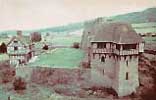
|
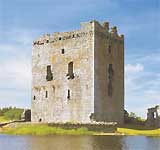
|
Stokesey Castle's wooden defences are raised to the top of the wall in the form of hoards, and give some idea of what 14th century Scottish fortified houses might have looked like. |
Threave Castle, Dumfriesshire still shows positions for putlogs to support timber wall walks. |
MUNICIPAL BUILDINGS IN THE ROYAL BURGHS
Tolbooths and bellhouses are the earliest municipal buildings in Scottish burghs, and the fact that many of the surviving buildings date from 1591 suggests they were constructed as the result of a Scotland-wide decision of the Convention of Royal Burghs. Although all the buildings erected in or immediately after 1591 comprise stone towers, none of the burghs appear to have purchased ground on which to erect the tolbooth. Similarly, when town houses were added to tolbooths in the 18th or 19th centuries, there was no purchase of land, suggesting that these masonry structures were replacements for timber buildings which had previously occupied the sites and served a similar purpose. Surviving tolbooth towers were probably originally built as fire safes for tolbooth complexes, with council rooms replaced by masonry structures in the 18th or early 19th century. Following the 1591 rebuilding there are no later records of municipal buildings constructed of timber. Many of the surviving tolbooth towers retain small areas of timber cladding some of which could be the original timber and, if so, almost certainly amongst the oldest examples of timber cladding in Scotland.
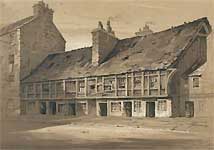
|
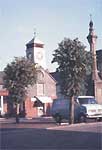
|
Timber-fronted land, Nethergate, Dundee. |
Partly timber clad belltower on the Tolbooth, Moffat, Dumfries-shire. |
DOMESTIC BUILDINGS IN THE ROYAL BURGHS
Scottish mediaeval burghs followed the same general pattern as medium-sized burghs in northern Europe. Regularly laid out, the tenements or building plots were on long narrow strips of ground running at right angles to the street. In the case of the larger burghs, the buildings (known as 'lands') were multi-storey structures in multiple occupation: the principal owner lived at first floor level, with other families being progressively poorer the higher they lived. In Edinburgh, additional lands were constructed to the rear of the principal land, while in Scotland generally, the period of major change from timber to masonry construction in both upper and upper-middle class urban dwellings appears to have occurred in the 17th century, such as in the Royal Burgh of Dundee where prior to the English invasion of 1547:
Many of the houses had wooden fronts supported at the ground floor upon pillars, within which were open piazzas, (the Scots name for arcading) sometimes used as the workshops of craftsmen and often as the booths of merchants. (11)
Following destruction by the English, these houses were rebuilt in the 1550's with timber fronts, and it was the beginning of the 17th century before legislation finally prohibited further timber buildings in Dundee. This did not cause an immediate change - in Dundee 200 years later:
The buildings were generally of wood. There were not then above half a dozen of stone houses in the High Street or Market place.(12)
At the end of the 18th Century, The Statistical Account for Scotland (13) recorded no more than four stone houses in the centre of Dundee. These were probably the townhouses of landed gentry who were displaying their exceptional wealth by building in masonry. Hume Brown's late 19th century collection of early travellers accounts gives a flavour of the building types in a late mediaeval royal burgh. For example, John Ray who visited Dunbar in 1662 commented:
They have a custom to make up the fronts of their houses, even in the principal towns, with firr boards nailed one over another, in which are often made many round holes or windows to put out their heads.(8)
Many of the records in Hume Brown's collection describe the transition from timber cladding to stone in the royal burghs, with Fynes Moryson describing the houses of Edinburgh in 1598:
The houses are built of unpolished stone, and in the faire streete good part of them is of freestone, which in that broade streete would make a faire shew, but that the outsides of them are faced with wooden galleries, built upon the second story of the houses; yet these galleries give the owners a faire and pleasant prospect, into the said faire and broad street, when they sit or stand in the same.(8)
Another account from Hume Brown states:
Their old houses are cased with boards, and have oval windows (without casements or glass), which they open or shut as it stands with their conveniency. Their new houses are made of stone.(8)
By the 1700's, the intellectuals of the Scottish Enlightenment were responding to new cultural influences and this, combined with increased affluence, meant that the 18th century building boom in Edinburgh was realised in stone. The older timber-clad houses in the royal burghs were progressively demolished or incorporated within new masonry walls and while there is no evidence that new timber-clad houses were built, it is likely that other types of timber-clad buildings (e.g. workshops and stables) continued to be constructed in the royal burghs.
RURAL SCOTLAND
Rural Scotland encompasses everything outwith the royal burghs. The majority of rural buildings were under the control of one or other of the landed estates. These estates ranged in size from about 75 acres in the case of Flatfield at Errol, Perthshire, to several thousand acres of rich arable land at Glamis in Angus, and to tens of thousands of acres in the larger Highland estates. In rural Scotland the estate factor took on the mantle of the Dean of Guild in imposing building control at the behest of the landowner.
VERNACULAR BUILDING TYPES
The range of Scottish vernacular building types has never been fully defined and to do so more 17th, 18th and 19th century rural sites need to be excavated. Unfortunately, it was the poor end of the social spectrum which survived until recently that has been recorded by students of vernacular building, but glimpses of interiors and exteriors of Scottish rural houses in the works of the genrÈ painters of the late 18th and early 19th centuries suggests a much wider range, both of structural types and external finishes. Using the structural system as a means of classification, there are four main types of timber structure known in rural Scotland: the cruck frame (sometimes called a 'couple' in Scotland); the post and longitudinal beam; the post and cross beam; and aisled construction. Because each of these systems transfers the loads to the ground without the need for structural external walls, it is possible that - where timber was available - it may well have been used for cladding these buildings.
The cruck frame typifies rural vernacular building in Scotland. Although a better class of cruck frame is known in England, the system appears to have developed in Scotland and Ireland before being exported South. Cruck frames offered several types of external building form for dwellings. One type had the roof oversailing a vertical wall while, at the other extreme, the roof stopped near the inner face of a broad turf wall (in the same manner as the roofs of surviving Hebridean blackhouses). Between these two extremes many other variations existed. Cruck-framed houses continued to be built in the Highlands until the 1920's and timber-clad cruck frames survived in Strathspey until the 1980's.
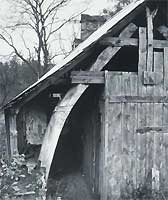
|
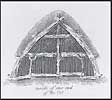
|
Timber cladding between the masonry base and eaves on a cruck-framed cottage at Kinchurdy, Strathspey. |
Cruck frame used in a Highland sheep cot. |
References
1 Lamb, A.C., 1895, Dundee: its quaint and historic buildings.
2 Foulis, R., 1852, Old Houses in Edinburgh and their Inhabitants.
3 Chambers, R., 1859, Edinburgh Papers including the Ancient Domestic Architecture.
4 Home, B.J., 1905, Old Houses in Edinburgh.
5 Home, B.J., 1907, Old Houses in Edinburgh.
6 Walker, B., The use of 'skaile' in Mediaeval and Post-Mediaeval Scotland. In: Antiquity No.75, 2001.
7 Langhelle, S.I., The Timber Export from the TysvÊr area in the 16th and 17th Century. In: Lokalhistorisk Stiftelse, 1999, Timber and Trade.
8 Hume-Brown, 1891 reprinted 1973, Early Travellers in Scotland.
9 Saltzman, L.F., 1952, Building in England down to 1540.
10 MacGibbon, D. and Ross, T., 1988, The Castellated and Domestic Architecture of Scotland.
11 Maxwell, A,. 1891, Dundee Prior to the Reformation.
12 Colville, A., 1822, Dundee Delineated.
13 Small, H., Parish of Dundee. In: Statistical Account for Scotland. 1793.
British Standards
BS 7359: 1991. Nomenclature of commercial timbers including sources of supply.
Contact
Email: Central Enquiries Unit ceu@gov.scot
There is a problem
Thanks for your feedback